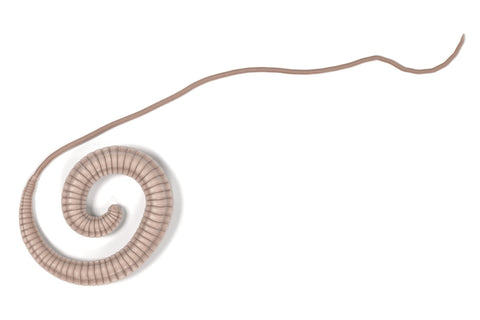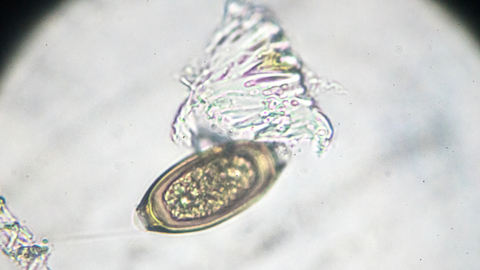Trichuris Trichiura: The Whipworm
March 30, 2024
Trichuris trichiura, more commonly referred to as the whipworm due to its distinctive shape, presents a significant public health challenge, especially in tropical and subtropical areas of the world. This parasite thrives in conditions where sanitation and hygiene are lacking. It affects millions globally and can cause a range of health issues that, while often treatable, can significantly impact quality of life, particularly among children. In this article, we will discuss what Trichuris trichiura is, its life cycle, transmission, diagnosis, symptoms, treatment, and prevention.
What Is Trichuris Trichiura?

Trichuris trichiura is a nematode, a type of roundworm, that primarily colonizes the human large intestine. It is commonly known as whipworm because its shape resembles a whip with a thicker posterior end and a thinner anterior end. (1) It is a common parasite that affects millions of people globally, primarily in tropical and subtropical climates.
Trichuris Trichiura Lifecycle

The lifecycle of the whipworm is a fascinating, though somewhat unsettling, process. It begins when a person inadvertently consumes the eggs of the parasite, which can occur through eating food or drinking water contaminated with soil that contains feces from an infected individual. Once ingested, these eggs hatch in the person's intestine, releasing larvae that mature into adult worms. These adults then reproduce, with females laying eggs that are excreted in the host's feces, completing the cycle when these eggs contaminate soil and water sources, ready to infect another host. (2)
Understanding this lifecycle is crucial for interrupting the transmission chain. It underscores the importance of sanitation, as the prevention of fecal contamination of soil and water can significantly reduce new infections.
Trichuris Trichiura Transmission
The primary mode of transmission of whipworms is the oral ingestion of their eggs through contaminated sources. (1) This mode of transmission underlines how critical environmental sanitation and personal hygiene are in preventing whipworm infections. In regions where people may not have access to toilets and go to the bathroom outside or in areas where sanitation infrastructure is poor, the risk of whipworm transmission is significantly higher. Similarly, the use of human feces as fertilizer, a common practice in some agricultural communities, can also facilitate the spread of this parasite.
Trichuris Trichiura Diagnosis
Diagnosing a whipworm infection involves identifying the distinctive eggs of Trichuris trichiura in stool samples. These eggs are notable for their barrel shape with transparent polar plugs at each end. Accurate identification of these eggs is a critical step in the effective treatment and management of whipworm infections. (2)
Trichuris Trichiura Symptoms

The symptoms of a whipworm infection can range from mild to severe and often depend on the number of worms present. In light infections, there may be no noticeable symptoms. However, with heavier infestations, a person might experience:
- Abdominal Pain
- Diarrhea
- Rectal Prolapse
- Weight Loss
- Anemia
- Growth Retardation
- Chronic Intestinal Bleeding
Trichuris Trichiura Treatment
Whipworm infections are typically treated with medications known as anthelmintics. (1) The most commonly used drugs include:
- Mebendazole
- Albendazole
- Ivermectin
Treatment may need to be repeated, especially in areas where reinfection is likely. Alongside medication, improving hygiene and sanitation practices is crucial to prevent reinfection and reduce the spread of the parasite within a community. It's important for patients to follow the full course of medication as prescribed, even if symptoms disappear, to ensure all the worms are eradicated. Health care providers may also recommend iron supplements if the infection has caused anemia.
Some people may prefer to use natural antiparasitic remedies instead or in addition to commonly used drugs. While these can be effective, it is recommended to consult with your doctor for proper diagnosis and treatment of infection.
Trichuris Trichiura Prevention
Preventing and controlling whipworm infections requires a multifaceted approach. At the heart of this approach is the improvement of sanitation and hygiene practices. This includes the construction and use of latrines to prevent human feces from contaminating soil and water, as well as the promotion of handwashing with soap, especially before meals and after using the toilet.
Moreover, public health education plays a pivotal role in prevention. Communities benefit from learning about how whipworms are transmitted and the simple yet effective ways to reduce infection risk, such as washing fruits and vegetables thoroughly and ensuring that food is cooked properly.
In addition to these preventive measures, the treatment of infected individuals with appropriate anthelmintic medications helps reduce the worm burden and mitigate the health impacts of the infection.
Summary
Whipworm, scientifically known as Trichuris trichiura, is a parasitic worm that causes infection primarily in humans, particularly in regions with poor sanitation. The life cycle of the whipworm begins when eggs are ingested through contaminated soil, food, or water. Once in the intestines, the larvae mature, and the cycle of reproduction and contamination continues.
Symptoms of infection include abdominal pain, diarrhea, rectal prolapse, weight loss, anemia, and in children, growth retardation and chronic intestinal bleeding. The risk of transmission is high in areas where proper sanitation is not available, emphasizing the importance of hygiene and public health interventions.
Treatment typically involves anthelmintic medications, with mebendazole and albendazole being the most commonly used. Addressing whipworm infections demands an integrated approach, including the improvement of sanitation, public education, and access to medical treatment. Through these measures, communities can break the cycle of infection, leading to better health and quality of life.
References
True Health Starts with Feeding the Body


